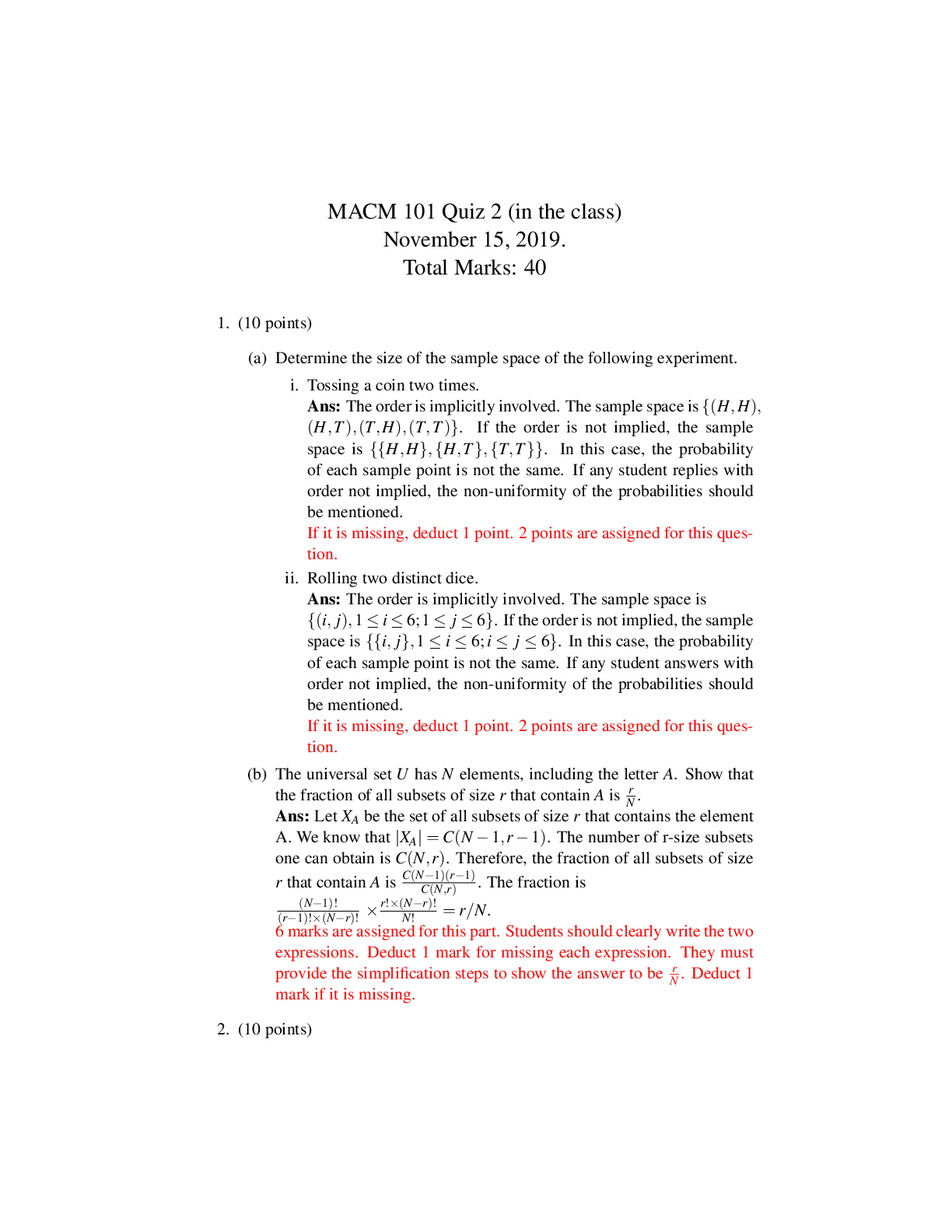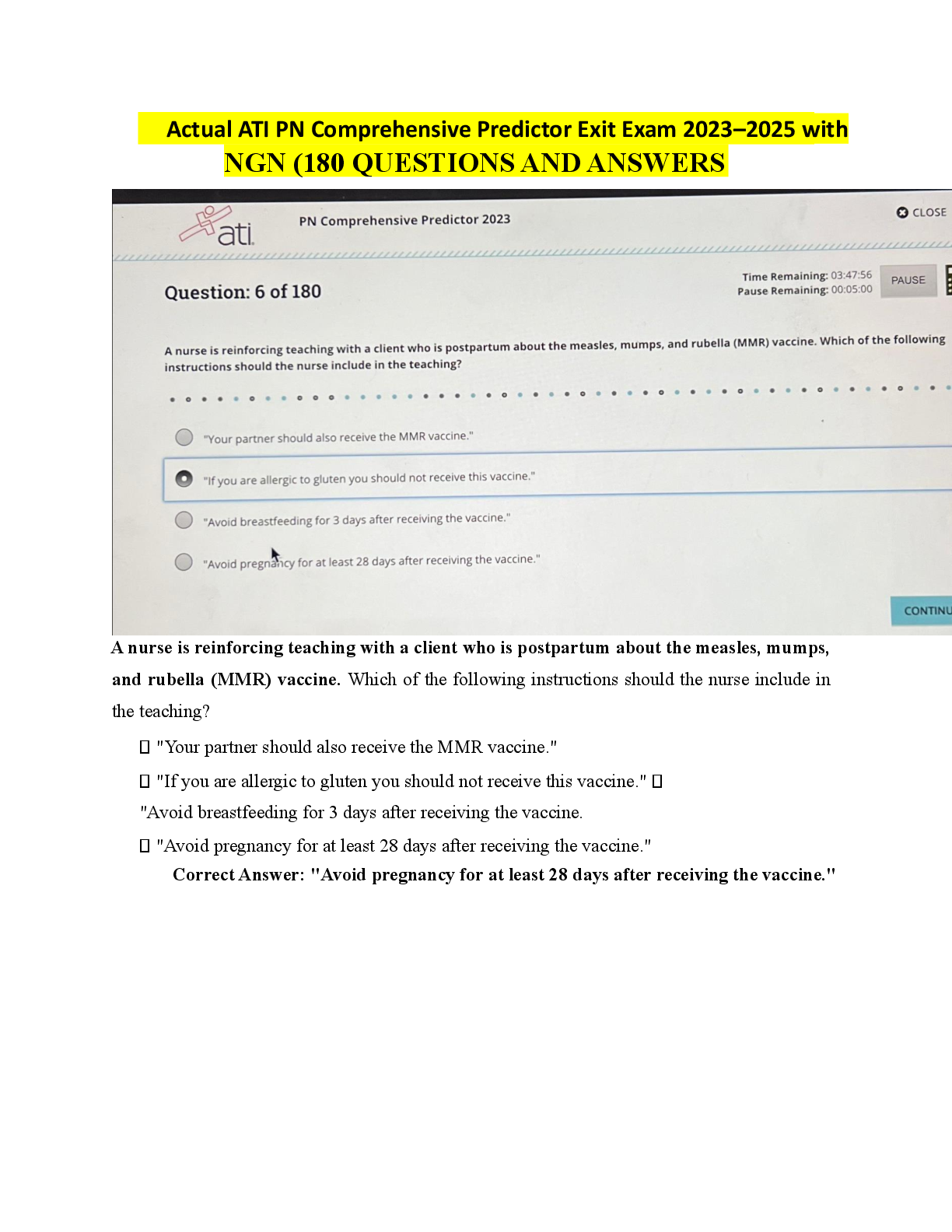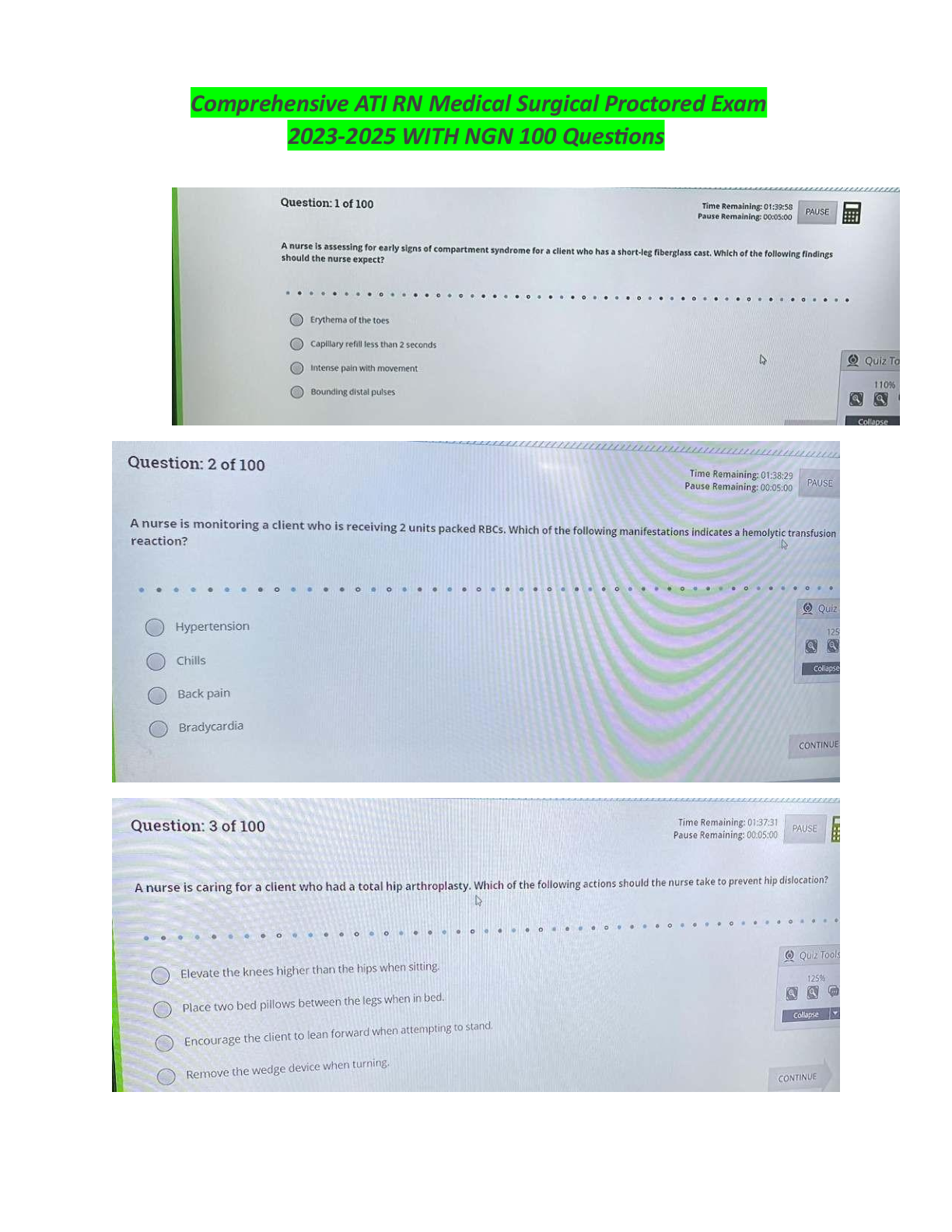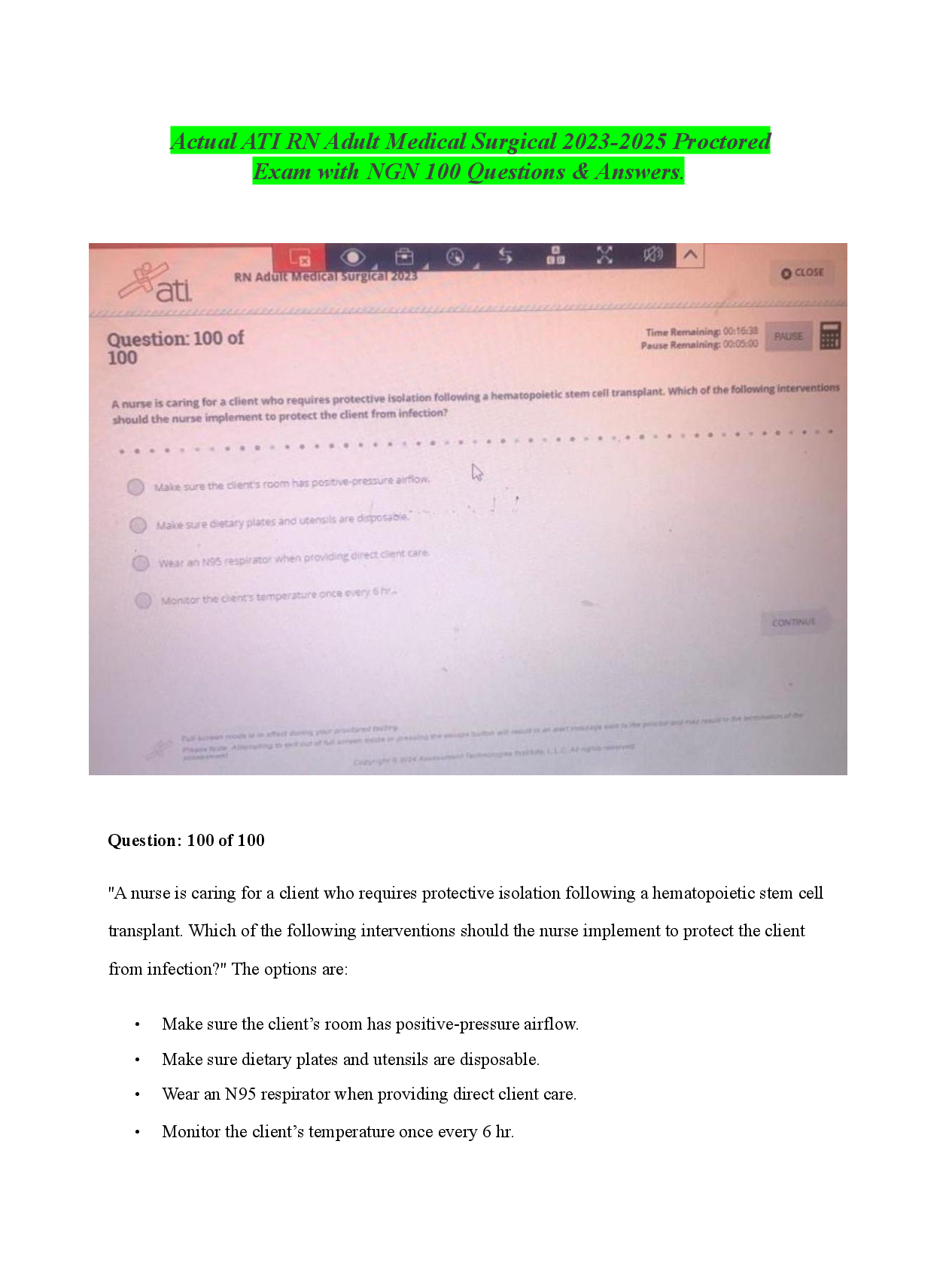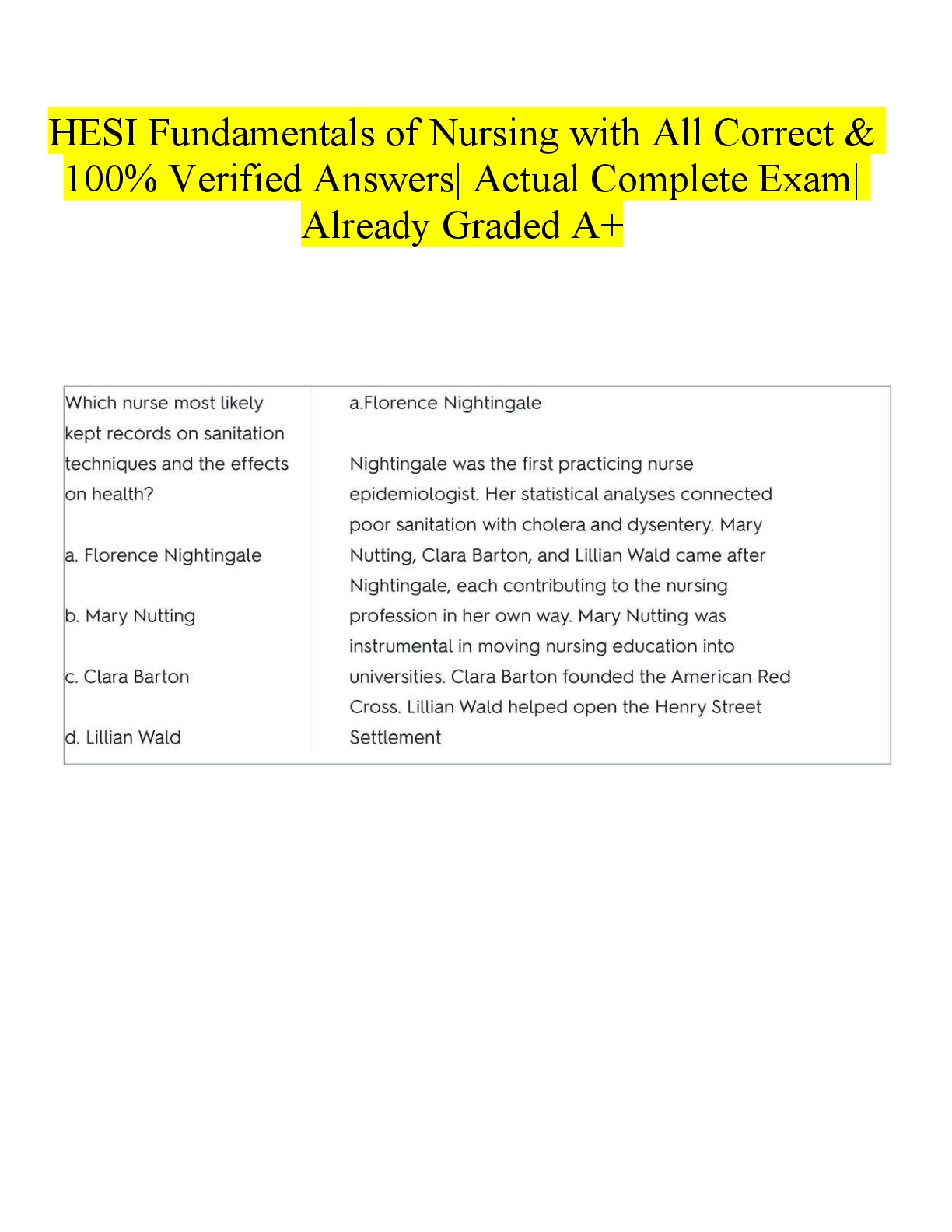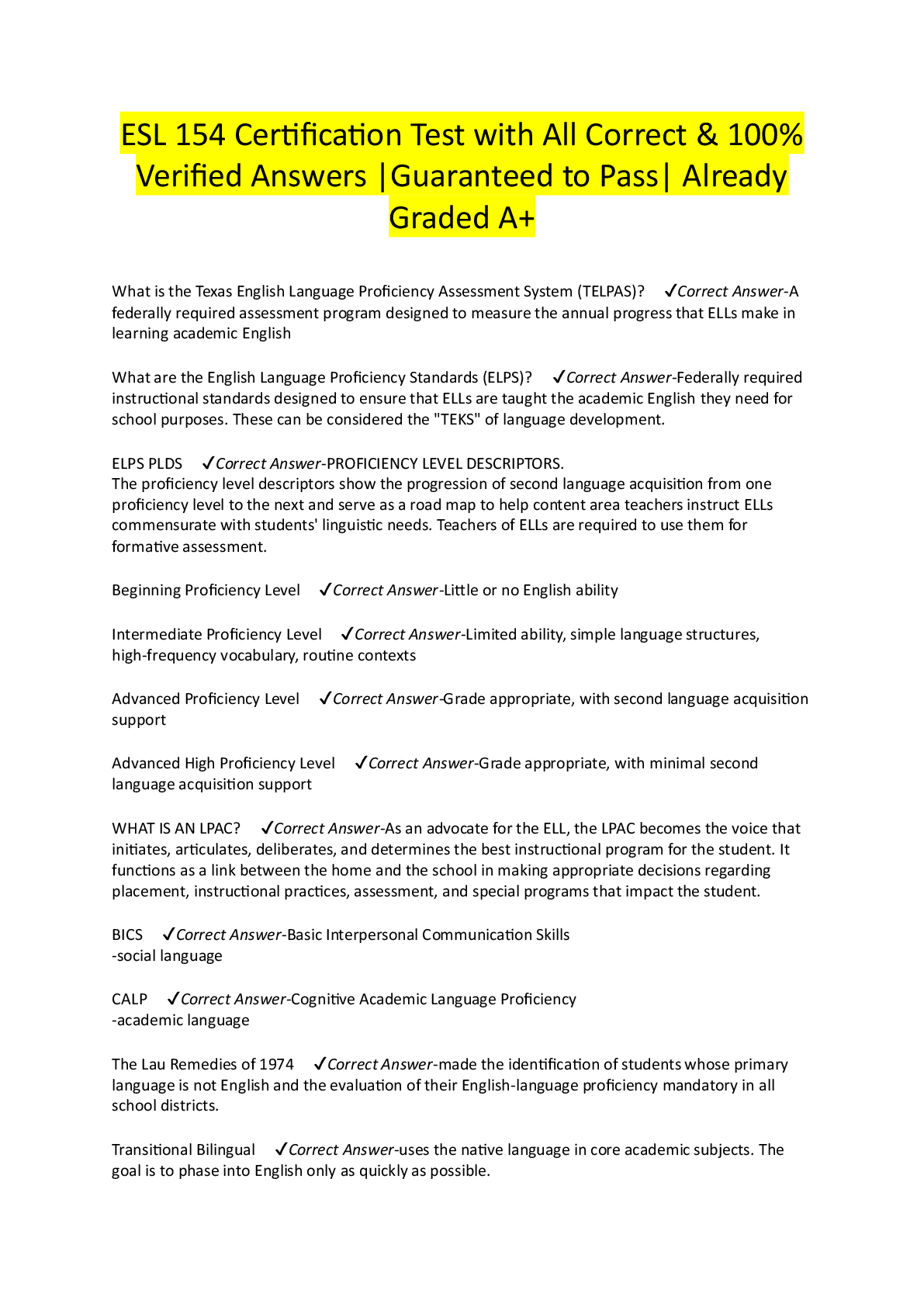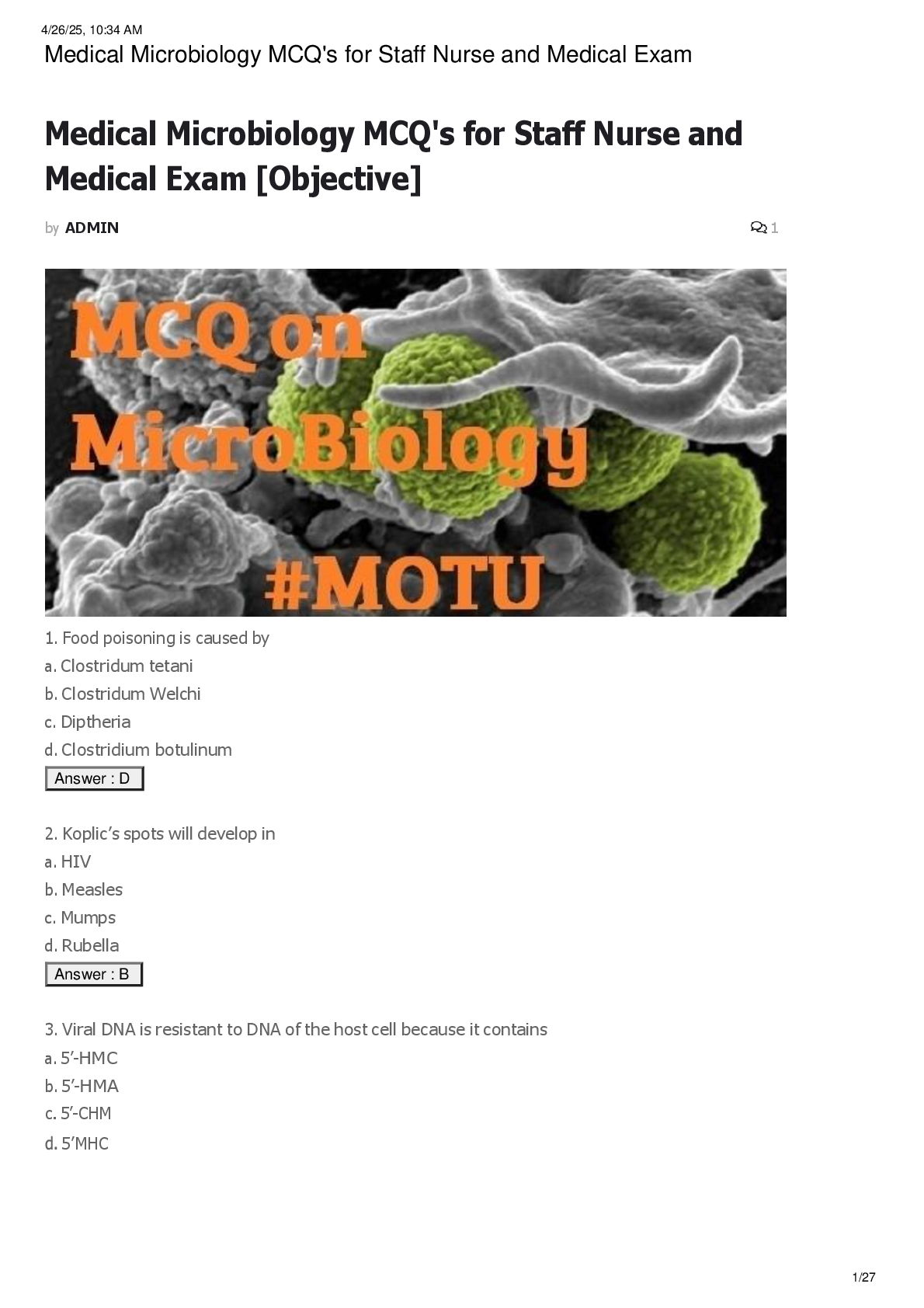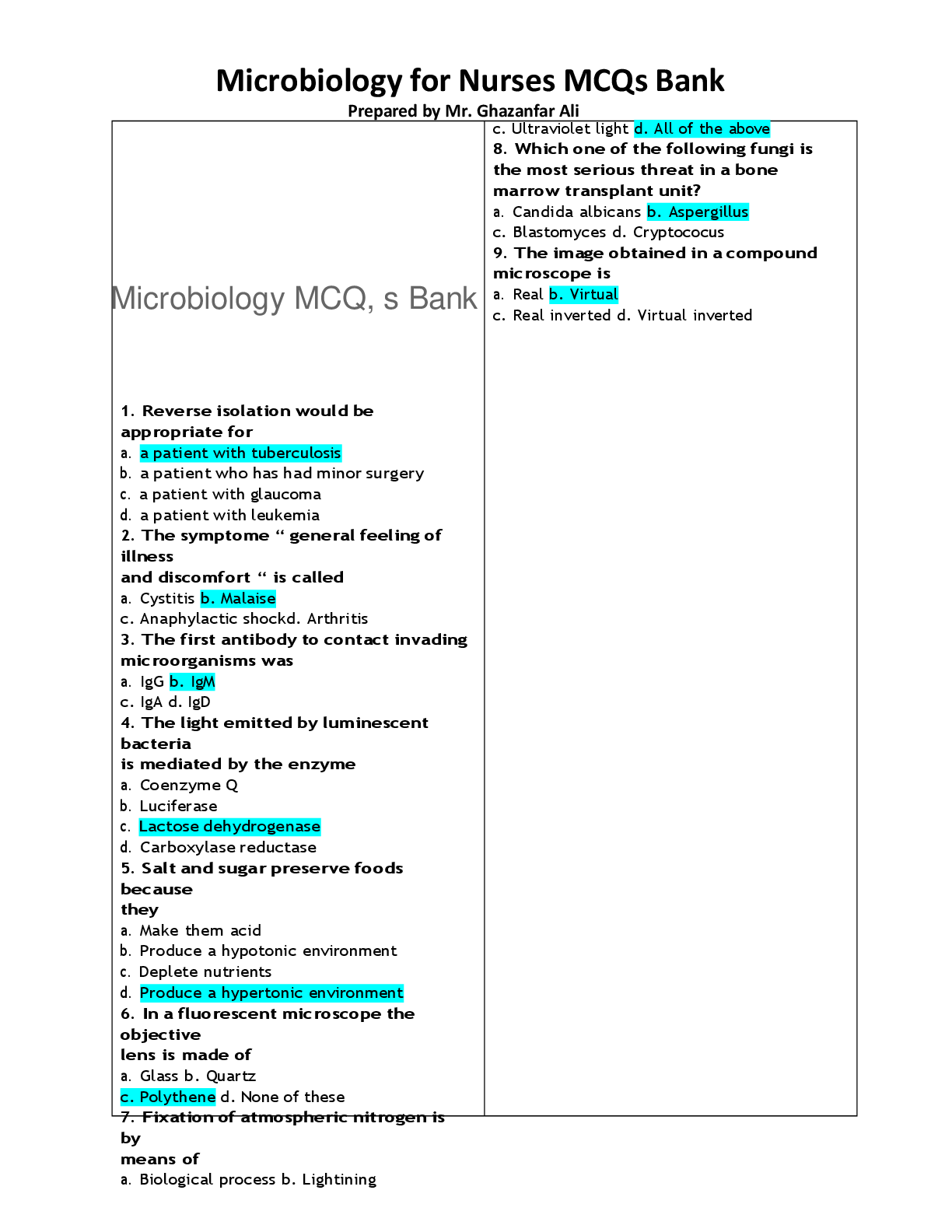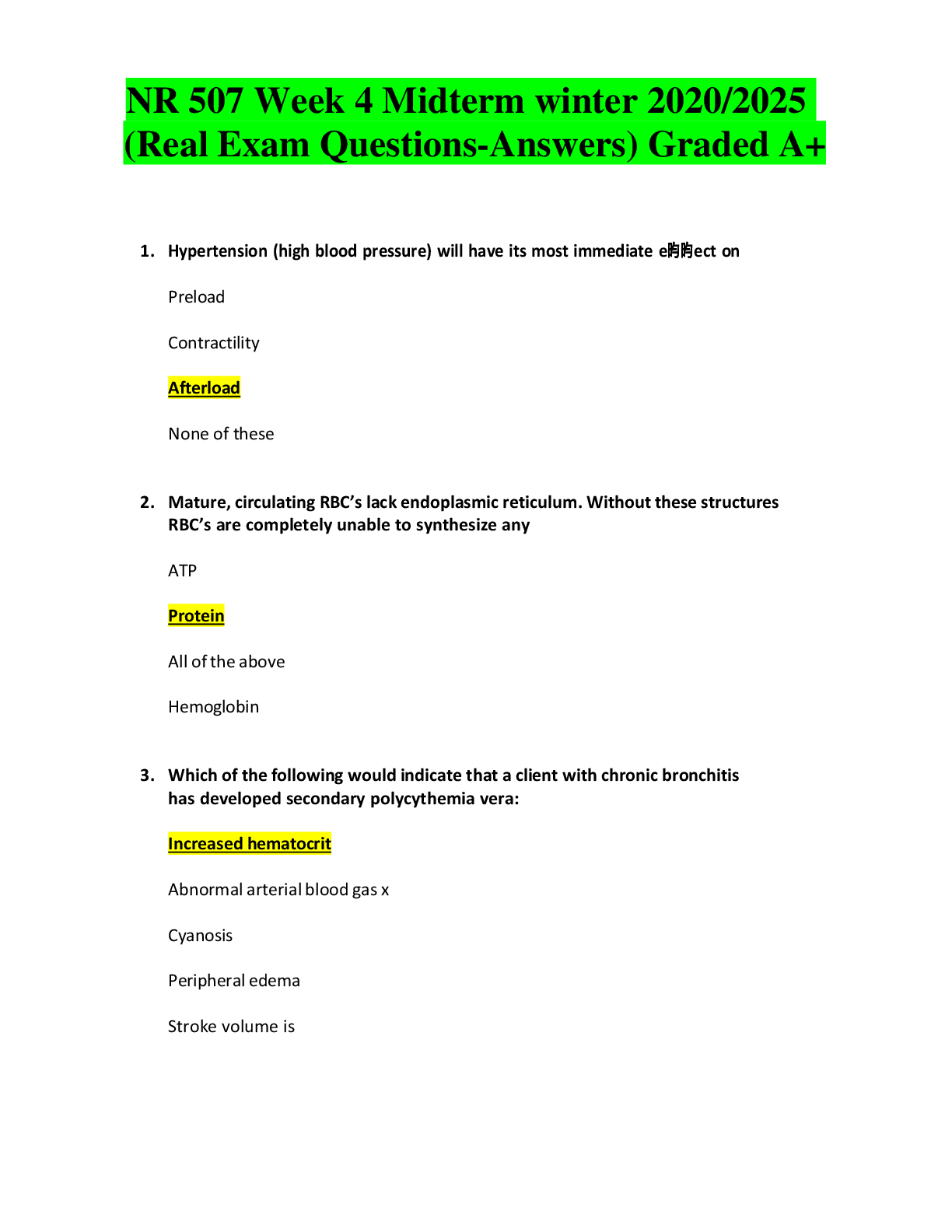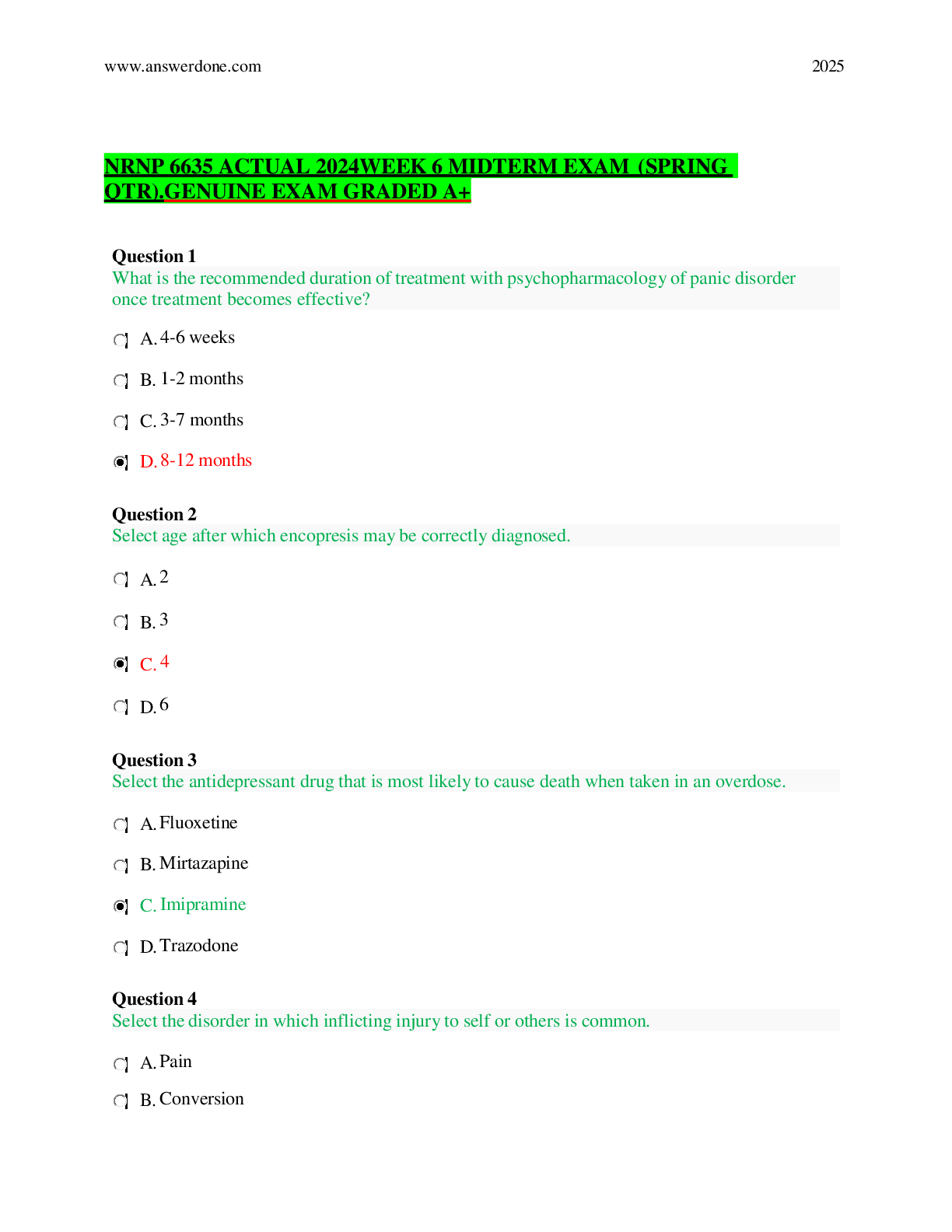Economics and Statistics > EXAM > ENMG 652/BETC 665 Fall 2020 FINAL EXAM (All)
ENMG 652/BETC 665 Fall 2020 FINAL EXAM
Document Content and Description Below
ENMG 652/BETC 665 Fall 2020 FINAL EXAM ENMG 652/BETC 665 Fall 2020 FINAL EXAM Management, Leadership, and Communications Fill-in-the-Blank Problems Exact word answers are required. Total points: 50 ... (5 pts. per question) 1. An understanding of how trust impacts a virtual team’s development will help managers and team leaders to facilitate and improve team success. 2. People develop trustworthy recipes for thinking as usual because they like predictability and dislike uncertainty. 3. In team building synergy occurs when the team members contributions exceed the sum of individual member contributions. 4. When coaching, if the manager provides direct instruction or guidance on how to design and implement a performance improvement plan, they are using a directive approach. 5. When someone wants to deliver a message, they encode and then send the message to the intended recipient who must decode the message from within their own field of experience. 6. When organizational learning rises to affect the organizational norms themselves, it is called double loop learning. 7. When you become the boss, you initially won’t have the feeling of more freedom, instead you will feel constrained by organizational inter-dependencies. 8. As a manager, to address items that are in your circle of concern, you must first concentrate on items in your circle of influence. 9. Confrontation is in order when you care about both the person and the problem at hand. 10. Social cognitive theory describes how learning occurs through interactions among people, behavior, and environment Short Answer Problems (Typically 150-300 words) Total points: 50 (10 pts. per question) 1. Mohammad is considerably younger than most of the people he supervises. He has a master’s degree and is mechanically inclined. Right out of college he went to work for a local manufacturer as a business analyst with an eye toward becoming a team leader. Mohammad learned his trade well and was promoted in just under a year to team leader. He is not only younger than anyone he supervises; he is better educated, too. How can he turn this situation into an advantage? How can he become a good supervisor of his older and more experienced workers? Ans: Mohammad being promoted as a team leader in the first year of work could have both positive and negative sides. The first thing that he would have to get hold of is winning the team’s confidence and building a bond with the team. When he wins the team’s confidence, all he would have to do next would be to create an environment that is engaging, warm and that is not threatening. Some things me should keep in mind to make the tables turn to his side are: • Respect: Respecting fellow team members and listening to their opinions is very important to any leader. In Mohammad’s situation, the team consists of highly experienced people and he has to respect their opinions. He should make use of his teammates experience and use it for the betterment of the company and try to involve the senior employees while taking key company decisions. • Communication: Communication is a powerful tool for any industry. A good supervisor, is both a good listener and a good communicator. And indirectly has the power to control the success of any business. Mohammad should be open to take suggestions from his team and use them while making decisions. Since he is more educated than his team members, he would possess better techniques to address some problems, which his teammates wouldn’t have knowledge of. Hence, the environment should be such that mutual learning is acknowledged and the team feel the sense of belonging. • Motivation: Mohammad should consciously make an effort to make the team feel motivated. He should surely recognize and appreciate the inputs by team members. By doing this, he would create a sense of belonging and the team would want to work more for him. 2. Because of downsizing and layoffs at her biotech firm, Soniya got a new department to manage. Previously she had managed the inspection and validation department. Now she must manage a new integrated manufacturing department pulled together from the remains of several group’s members left after the downsizing. What are the five stages of rebuilding a team’s trust that she should pay attention to? What level of trust needs to be fostered at each of the levels, and what would you suggest she do to as the team leader to create and sustain trust for her manufacturing group considering the reorganization? Ans: Soniya is now in a situation where she has to build the team’s trust from scratch. Team building has five stages: • Establishing the team: This is the first stage of team building and Soniya should create her team based on the required skill sets. She should also take the initiative to make everyone get familiar with each other and should be mindful of ambiguity while assigning the work to the team member. Also, in this stage, the dispositional trust tends to arise which must be fostered carefully. This stage is the foundation for development of trust in the newly forming team. • Inception: Soniya has to use this stage to build on the foundation laid previously. She should develop a swift trust that should promote the connectivity. At this level, the trust level is on superficial levels since the members don’t have working experience with each other and the trust is on personal level. The bonds of cohesion will develop into trust between the members. • Organizing: At this is the stage, the trust in the teammates’ ability and integrity has to be nurtured. This would help Soniya to develop participation and organizing activities among the team members. Organizing work as per skill sets and trying to get the team members together would develop cognitive trust in the team. • Transition: At this stage, the transition from integrity and ability to benevolence and integrity would take place. Here, the team’s focus would move from the procedures to accomplishing the task • Accomplishing the task: At this stage, the trust in teammates’ benevolence and integrity has to be fostered. Moreover, Soniya should pay attention to communicate the importance of trust between the members of the team, as it will be important to determine the efficiency of the team as a whole. Incorporating team building exercises to break the barriers, would help the members to communicate and work more efficiently. 3. Ken Kendricks, a sales manager at Emergent Biosciences was promoted to a managerial position at headquarters, where he was responsible for sales-people who serviced his company’s largest accounts. His new boss told him that his primary job was to influence others’ success more than achieve new goals himself or socialize with his subordinates. However, in talking to you Ken revealed that he did not agree with his boss’s directive. He told you that his would lead by demonstrating his need for achievement he had no need to exercise power. Ken’s high need to achieve was no surprise—after all, he had been a very successful salesman—but obviously his desire to influence others was much less than his job required. Then came the real shocker. Ken’s subordinates confirmed what his stories revealed. He was a poor manager, having little positive impact on those who worked for him. They felt that little responsibility had been delegated to them. He never rewarded them but only criticized them. And the office was poorly organized, confused, and chaotic. Name the four types of personal power that Ken can invoke to help him in his new position, and briefly describe an example of how he might use each of them to help him advance in his new role. Ans: Ken’s new position is to manage a bunch of sales people who were serving the company’s most import accounts. He was mainly asked to influence these people using his power. It feels like Ken lacks the skills to lead a team and use the power to delegate the responsibility amongst the team members, given their mistakes from the past manager. To be an influential leader, Ken has to know how to exercise his power efficiently. Power is of two types, Personal and Positional. The first being that from the personal traits of an individual and the latter being the one that comes from the position in the company. Ken now possess the positional power in the company and he has to work on his Personal power. The four types of personal powers are: • Expertise: This is the power derived from the individual’s knowledge or expertise in the particular field of the operation. This is very valuable and Ken could demonstrate it to his team by talking to them about his past experiences in the field and sharing some tips about how they could improvise on their skills. • Rational Persuasion: The ability to control the behavior of people by a logical or positive discussion. Ken could speak to the team about the growth or the lack of it and try to influence them to push their limits by using his verbal qualities. This could drift in a negative direction sometimes, when confrontations are taken as a bad sign. Hence, He should exercise this power very consciously. • Reference: A power that is derived from the charisma of the person. The personal traits and the aura can play a role to inspire individuals to follow them. This trait is more in-built rather than acquiring it over the time. Going with the team, sometimes, would help him demonstrate his skills, and bring a hope of inspiration to the team. Being a role model for someone is referent power and influences the behavior of the people following you. • Coalition: The ability to control one’s behavior indirectly because the individual has no obligation to someone as a part of a larger collective goal. This kind power arises from mutual obligations. Ken could establish coalition power by ensuring that there is mutual respect between the sales people and him, making sure that both of them would have each other’s back when needed. 4. Regarding Chapter 60 “The Threefold Way” in The Ropes to Skip and the Ropes to Know, can Kerry possibly refuse? Imagine yourself in Kerry’s position and evaluate the situation from that perspective and recommend a path forward for Kerry. Ans: Kerry Drake has been with The Company throughout its path to growth. So, he has a good knowledge of the loopholes to get things done the way he wants. But situation now seems like the tables have changed. Kerry, who was never questioned about his doings is now being targeted, as The Company wants to know the happenings in that department, very briefly. All these years, Kerry had the power to use his Positional, Expertise and Persuasive power. He has been very authoritative all this while and is too used to it. While changes should be accepted, as the way of things happening change, Kerry being stubborn about it has put him into this situation. He feels this as a big bait, but on The Company’s note, this is for something positive. They are giving him the position so that they can use his expertise and experience to get the better of him. But Kerry is really stuck to what he’s been doing and likes whatever he’s doing as it is just the way he wants. But what Kerry has to realize is that things have been changing since the company is not small anymore. And this is all that is happening in the initial days itself. It would get worse and he would have to let go of his old ways of getting things done in his way. If I were in Kerry’s situation, I would analyze the way things could get in the near future. I know that I will no more be in a position to do things the way I personally want to, even though I’m meeting the demands of the company. I wouldn’t want it to be a daily headache of addressing why I would want to do one thing in my way. Hence, I would rather take the new opportunity given to me and try to make the most of it, by using all the knowledge that I have acquired in these years. As a good resource to the company, one should always accept changes as they come, and learn to adapt instead of cribbing about it. 5. In this video: https://www.youtube.com/watch?v=8cPeU75Fha0 George Hobica refers to the recent United Airlines incident as “the worst response to a public relations crisis that I have ever seen”. Given your new understanding of moral/legal/ethical/policy issues and your new insights into crisis management. Outline a better way for United’s management to have handled this incident. Additionally, with your new understanding of crisis management, draft an outline of the items you feel United has done well since the event, and what you would have done differently. Ans: The act of removing a passenger from a flight is worth of a strong condemnation and the part where United Airlines resorted to this kind of an act makes the incident more awful. On top of it, the way the situation was handles is even more disastrous. Living in a civilized society, such actions should be handled in a more civilized nature, no matter the situation. In this case, not only legal standards were violated, but also the moral, ethical and basic policies were violated. Treating the customers well is something that is at most expected from a customer service industry, because the industry’s key person is the “Customer.” It is the basic duty of a company to provide the best service to a customer. The incident could’ve been totally avoided, only if they tried to accommodate the passenger in a different way. While several options being, accommodating him in a different flight, letting him use the airport lounge, usually given to the first-class travelers and maybe also upgrading his seat on the next flight. They should’ve also realized that the whole situation was because of their necessity and have to accept that fact. Following the incident, it was the company’s duty to apologize to the affected individual and in a meaningful way. Importantly, empathizing with the people who were impacted by the incident was a must. The airline should change their procedures and make sure that they shouldn’t repeat such actions again. Also, if such emergency actions are a must-do, they should do it in a more civilized manner and with the customer’s consent. Case Study Problem Total points: 100 From your course pack, read, analyze and prepare a 3-page case study report for the Hartalega case in your HBP course pack. Remember to check your work against the grading rubric before you make your submission. Case Study: Satya Nadella at Microsoft: Instilling a Growth Mindset Introduction: Microsoft corporation is an American multinational technology company which is headquartered in Redmond, Washington founded by Bill Gates and Paul Allen. Satya Nadella took over as the third CEO to the company in the year 2014, when the company was in dire shape. Microsoft had maintained a long-standing legacy in the Silicon Valley, but they needed a new strategy to compete against its more nimble counterparts like Apple Inc. and Alphabet Inc. [1] Microsoft used to be infamous for its toxic corporate culture and had many instances of being laughed at about it. The figure 1 shows a classic cartoon from Manu cornet showing the Microsoft org chart before Nadella took the CEO’s position. But under Nadella’s leadership, Microsoft has embarked a major transition towards becoming a tech-giant and has led to many organizational changes inside the company. [1] Figure 1 Main Challenges: When Nadella inherited the company, the wasn’t in a good shape. There were several things that were to be corrected or paid attention to in a different and more sensible way. Some of the main challenges he faced were: • Stack ranking: Stacked ranking is an employee evaluation method that slots a certain percentage of employees into several levels of performance. [2] This kind of stack ranking system hurt the performance and also the managers were forced to rank all of their employees in a bell curve. It had been a huge source of employee discontent. [3] • Talent jump: The growth of new firms led the talent that once Microsoft beheld to jump ship. The talented employees were leaving the company faster than they could be replaced. The main reason for this was due to the work culture, where ideas were not appreciated or supported. Lots of people saw the other rising companies offering a better place to portray their talent and decided to move. This made holes in the company that was once the leader in innovation. • Lag in product development: The new products that came out of the company did not do well with respect to the similar products by the competitors. Microsoft was caught between serving businesses and customers. [4] • Morale plummeted: The leaders of the company faced a bad rating on public sites like Glassdoor among their own employees, while their competitors were on steep rise. • Products were fading towards irrelevance and stock prices stalled: The new products from the Apple and Google soared in the market and though Microsoft’s revenue and profits were well, the stock price was flat. Causes: The causes for all the unexplained challenges the company faced were not new in the history of industries. But the way they were to be addressed and doing them in a timely manner was important. The actions shouldn’t be short lived or done unmindfully. • The performance management system’s use of stack ranking was awful. The forced distribution meant that the someone would always receive a poor rating, regardless of the amount of effort they’d put in. It was initially used to promote mid-range employees to aspire top level ranking, simultaneously increasing profits. But this in turn, showed the other as under performers, even though they put extra effort. [1] • The rise of companies that paid more attention to innovation and meeting the world’s fast-growing needs, gave hope to the talents that were struggling at Microsoft as a limelight. Hence, a lot of top-talented employees left the company which affected the company’s talent pool. • The fast-growing industry, had higher expectations. And the new rising companies met those expectations. Microsoft’s untimely entry of products into the existing market, didn’t pay of the way it was expected to. This hit the way the company functioned and how it went of the limelight. • When the employer doesn’t listen to the needs of the workers, their confidence in him would be lost. The leaders at Microsoft didn’t listen to the screams of the workers and hence this hit the way the workers treated the employer. • While the competitors’ products soared to record market valuations, the products from Microsoft failed to hit the prices. One of the reasons were due to late entry into the market and also the lack of innovation in the products. Recommendations: A good leader who wants to change the way the organization is now stationed, will always look into the roots of the problems, instead of directly attending them. This was exactly what how the CEO of Microsoft, Satya Nadella brought changes to this firm. Under his leadership, the value of the company tripled. The way the culture and fresh strategies the company received were the main causes. He had a great perspective on the ups and downs of the company and addressed it by paying at most attention. [5] Organizational transformation, the collective self-transformation is one that is characterized by audacious experimentation, insatiable curiosity and a culture driving towards relentless levels of innovation and collaboration, has been one of the keys of Microsoft’s back into track. [6] A transformational change in an organization must ultimately change the concept regarding the way the organization is identified and what it means to you when it comes to self-concept. Listening to the deepest concerns and making the employees feel included in the changes that are brought about in the company has been a key to why Nadella’s leadership has embarked a major transition in its journey. [1] Keeping up to the expectations of the world and doing it timely would also be the key to success. Summary: In conclusion, the transformation of a company which lost its shine due to unattended small problems, grew into big challenges leading the company to a rough path. Leaders like Nadella, who pay attention to the smallest of the details while addressing them and being mindful about the decisions they make, show that the company that was once trolled and being assumed to get crippled down, has made it to the top companies of the world. Leadership and organizational culture are the two main takeaways from this case. Changing the way Microsoft has been evolved from figure 1 to figure 2 is very inspiring. Figure 2 [Show More]
Last updated: 3 years ago
Preview 1 out of 7 pages
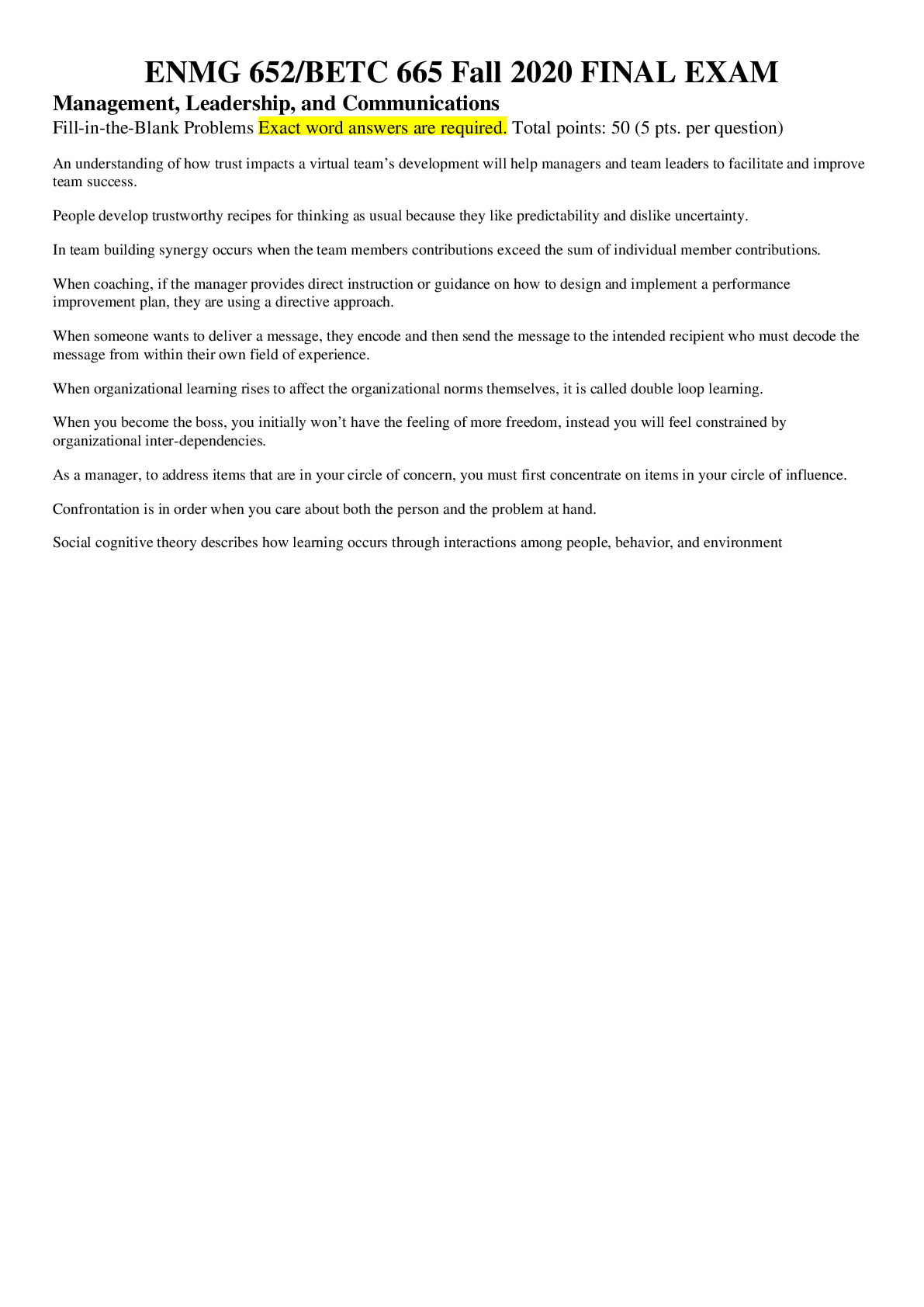
Buy this document to get the full access instantly
Instant Download Access after purchase
Buy NowInstant download
We Accept:

Reviews( 0 )
$8.00
Can't find what you want? Try our AI powered Search
Document information
Connected school, study & course
About the document
Uploaded On
Oct 28, 2022
Number of pages
7
Written in
All
Additional information
This document has been written for:
Uploaded
Oct 28, 2022
Downloads
0
Views
171










